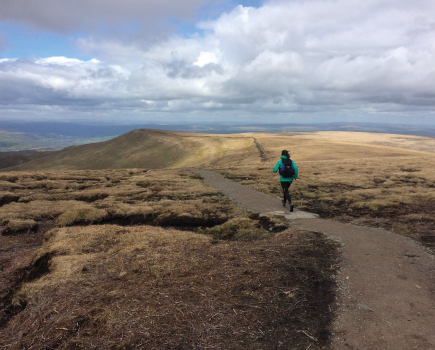Advanced navigation expert Lyle Brotherton explains surprisingly simple techniques using the sun and moon to hold a bearing, and use the sun to determine direction
Celestial navigation was the first comprehensive direction-finding system, used as long ago as 1200BC by the Phoenicians to travel across the seas. Today celestial navigation is still an essential component of course-plotting used by all mariners, and yet we have let it slip by the wayside in land navigation,
with the exception of our military Special Forces, who routinely employ the celestial navigational techniques. It’s much easier than you imagine. There are some highly effective techniques that are simple to learn, which can make our navigation more straightforward. We will look at these in this and the next issue of TGO. This form of navigation is based on the earth’s constant and predictable relationships with the moon, stars, planets and the sun to provide us with a wealth of navigational information from determining the cardinal points to calculating local magnetic declination.
Using the sun to hold a bearing
This technique uses the sun or moon to keep you heading in the right direction. It doesn’t replace the use of a compass, but instead helps you to maintain a
certain route. Using the sun, or at night the moon, gives you a reference to the cardinals of the compass.
1. Face the direction (bearing) you are going to travel and reach out with your arm as if you were going to grab hold of the sun and hold this position for a couple of seconds: this helps imprint your orientation to the sun.
2. Lower your arm and move forward, keeping in mind where the sun should be in relation to you.
3. You can travel for 10 mins on a single bearing using this technique before you need to repeat it.
4. If the sun is behind you, use your shadow. Reach out and hold your arm parallel with your shadow and hold this position for a couple of seconds.
Using this technique frees you up from having to constantly refer to your compass or map and instead allows you to concentrate on your surroundings and enjoy the scenery. Mountain rescue dog handlers routinely employ this method so they can concentrate on their dog and visibly search the area themselves.
Using the sun to determine direction
On any day you can calculate the exact position of the sun in the sky at a specific time and use this to not only navigate but also to check your compass is working correctly or, even if you lose your compass, still determine your bearings.
You can create a sun timetable for anywhere in the world, and on any day, by using the USNO (The United States Naval Observatory) website – http://aa.usno.navy.mil/data/docs/AltAz.php – where you simply enter the date you will be travelling, the time interval you require for the data and the location in longitude and latitude.
When you click ‘Compute Table’ this is what you get:
HRS MIN ALTITUDE AZIMUTH
06:00 -10.0 88.4
07:00 -1.8 101.0
08:00 6.1 113.7
09:00 13.0 127.0
10:00 18.9 141.2
11:00 23.1 156.5
12:00 25.3 172.6
13:00 25.2 189.1
14:00 22.8 205.1
15:00 18.4 220.3
16:00 12.5 234.5
17:00 5.5 247.7
18:00 -2.5 260.4
19:00 -10.6 273.0
Altitude refers to the height of the sun above the horizon in degrees, so negative values mean that the sun is below the horizon and you will be unable to see it. The compass bearing of the sun is referred to as the azimuth, which is a term more popular in America. (The bearings are True North).
Determining the cardinals of the compass from the sun
From looking at the chart above, anywhere on the Cairngorms at 06:00hrs the sun will be due east of where you are (Azimuth 88.4°), yet beneath the horizon (Altitude -10°) so you will not be able to see it directly. However, because it is only -10 degrees beneath the horizon, the sky with be very bright above it and you will be able to reference due west and therefore easily determine where North, East and South are.
Checking your compass bearing is correct using the sun
As the sun rises and becomes visible you can take very accurate bearings from
it. For example, at 08:00hrs it is on a bearing of 113.7° and 6 degrees above the horizon, so clearly visible (Azimuth 113.7, Altitude 6.1°). So let’s say that you needed to head off on a bearing of 160° and it is 08:00hrs. Using the sun it is very easy to estimate the extra 46.3° to sight your attack point (45° is half a right angle), by simply estimating this extra distance to the right of the sun. If your bearing is larger than the sun’s bearing it will be to the right of it and if it is smaller, it will be to the left.
Using the sun to take bearings
If you have lost your compass or it has been damaged, the sun can be used to take bearings and follow them. Using your watch face, each hour represents 30° where 12 o’clock is North (0°), 1 o’clock will be 30° and 2 o’clock 60°, and so forth. Let’s say that your compass needle has stopped functioning correctly and you still have your map and sun timetable:
At 14:00hrs (2 o’clock)
• The sun’s bearing at this time is 205.1°
• 7 o’clock on your watch face is 210°
• Align 7 o’clock with the sun (it will only be 4.9° out)
• Now north is at 12 o’clock, east at 3 o’clock and so forth
• If you need to travel on a bearing of 300° this is 10 o’clock on your watch face and the bearing you need to walk
You can make this method as accurate as you want. Each minute spacing on your watch face represents 6° so in this example you would align the sun with 34 minutes on your watch face (one minute behind the 7 o’clock). Print this table out, preferably on waterproof paper, and take it with you on your journey. The table you compute is accurate for a large area. In Scotland you can travel around 100 km east or west before the values change by 1° and 500 km north or south for the same change. In addition, they remain precise enough for general navigational purposes for 10 days.








